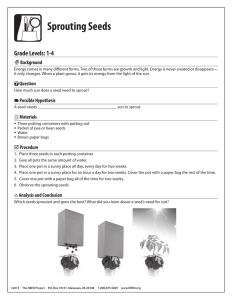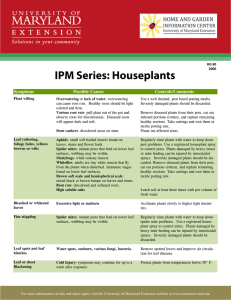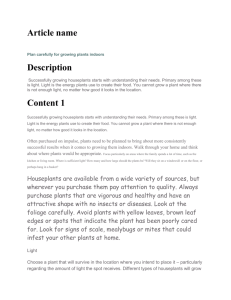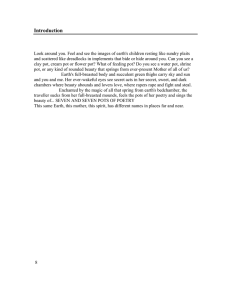IPM Series: Houseplants Symptoms Possible Causes Controls/Comments
advertisement
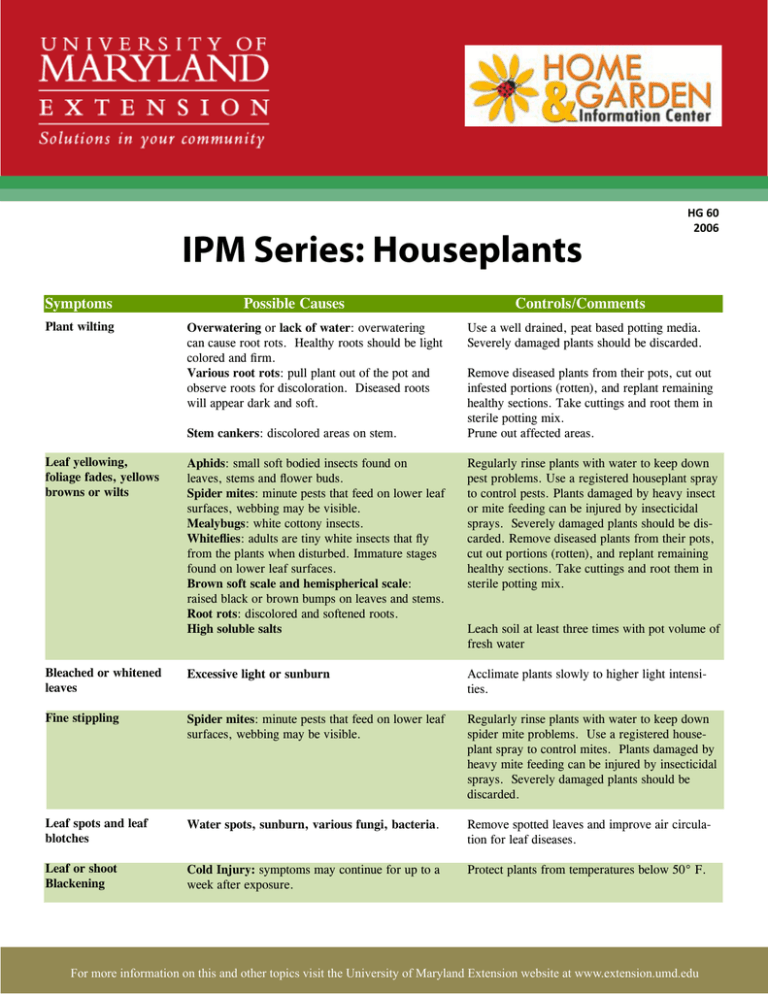
IPM Series: Houseplants Symptoms Plant wilting Possible Causes Overwatering or lack of water: overwatering can cause root rots. Healthy roots should be light colored and firm. Various root rots: pull plant out of the pot and observe roots for discoloration. Diseased roots will appear dark and soft. Stem cankers: discolored areas on stem. Leaf yellowing, foliage fades, yellows browns or wilts Bleached or whitened leaves Fine stippling Leaf spots and leaf blotches Leaf or shoot Blackening HG 60 2006 Controls/Comments Use a well drained, peat based potting media. Severely damaged plants should be discarded. Remove diseased plants from their pots, cut out infested portions (rotten), and replant remaining healthy sections. Take cuttings and root them in sterile potting mix. Prune out affected areas. Aphids: small soft bodied insects found on leaves, stems and flower buds. Spider mites: minute pests that feed on lower leaf surfaces, webbing may be visible. Mealybugs: white cottony insects. Whiteflies: adults are tiny white insects that fly from the plants when disturbed. Immature stages found on lower leaf surfaces. Brown soft scale and hemispherical scale: raised black or brown bumps on leaves and stems. Root rots: discolored and softened roots. High soluble salts Regularly rinse plants with water to keep down pest problems. Use a registered houseplant spray to control pests. Plants damaged by heavy insect or mite feeding can be injured by insecticidal sprays. Severely damaged plants should be discarded. Remove diseased plants from their pots, cut out portions (rotten), and replant remaining healthy sections. Take cuttings and root them in sterile potting mix. Excessive light or sunburn Acclimate plants slowly to higher light intensities. Spider mites: minute pests that feed on lower leaf surfaces, webbing may be visible. Water spots, sunburn, various fungi, bacteria. Cold Injury: symptoms may continue for up to a week after exposure. Leach soil at least three times with pot volume of fresh water Regularly rinse plants with water to keep down spider mite problems. Use a registered houseplant spray to control mites. Plants damaged by heavy mite feeding can be injured by insecticidal sprays. Severely damaged plants should be discarded. Remove spotted leaves and improve air circulation for leaf diseases. Protect plants from temperatures below 50° F. 1 For more information on this and other topics visit the University of Maryland Extension website at www.extension.umd.edu Leach excessive fertilizer from potting mix by flushing with water or repot with fresh potting media. White powdery coating on leaves Abiotic stresses such as over-fertilization, high soluble salts, lack of water: scorching symptoms can occur along leaf margins or between veins. Aphids: small soft bodied sucking insects. Cyclamen mites: predominately a pest of flowering plants. New growth is affected first. Viruses: foliage appears mottled green and yellow. Plants may be stunted. Viruses: foliage appears mottled green and yellow. Plants may be stunted. Powdery mildew fungi: grows on the leaf surface. Fuzzy gray growth on leaves or flowers Grey mold: frequently infects old faded flowers or older, lower foliage. Provide better air circulation. Pick off infected flowers or leaves. Remove old blooms or foliage. Leaf scorch Stunted, twisted and distorted plant growth Leaf mottling Fluffy white wax Leaves eaten or chewed Few or no flowers Spindly growth Poor growth Flying insects Insects in potting media Mealybugs: white cottony insects may occur on foliage, in leaf axles, leaf sheaths, roots and bud scales. Check plants that have been outside for the summer for pests such as caterpillars, leaf feeding beetles, weevils, grasshoppers, crickets, slugs, and earwigs. Low light levels, excessive fertilizer, cyclamen mites. Low light levels or excessive fertilizer, (high soluble salts) Poor culture, insects and diseases Whiteflies: tiny white insects flying around plants. Fungus gnats: tiny black flies flying near plants or near light sources. Ants, sowbugs, springtails earwigs, millipedes, slugs, slugs: often brought in from outside when relocating plants from outdoors. 2 Aphids can be controlled with a stream of water or with a registered insecticide. Cyclamen mite infested plants and virus infected plants cannot be cured and should be discarded. Discard infected plants. Provide better air circulation and pick off infected leaves. Spray with a registered fungicide if disease is severe. Check horticultural oil labels for powdery mildew control listings. se a registered houseplant spray to control mealybugs or use a cotton swab dipped in alcoohol to kill individual mealybugs. Hand pick pests and repot plants before moving plants inside. Increase light levels by relocating plants closer to a light source or add additional artificial light sources. Cyclamen mite infested plants should be discarded. Increase light levels by relocating plants closer to a light source or add additional artificial light sources. Reduce fertilizer applications during winter. Irrigate from the top of the pot to leach out excess fertilizer salts. Use a registered insecticide for whiteflies. Allow potting media to dry between waterings. Repot plants with fresh potting media. Beneficial nematodes may be used to control fungus gnat larvae. SELECTING INDOOR PLANTS Intensity: Select house plants that can withstand the particular conditions inside your home. It’s easier to purchase a plant requiring the same environmental conditions your residence has to offer than to alter the environment of your home or office to suit the plants. Pay particular attention to the plants’ light requirement. • Depends upon the distance of the light source from the plant; the intensity decreases rapidly with increasing distance and canopy size. • Influences the manufacture of plant food, stem length, leaf color, and flowering. Select plants which: • Affected by the direction the windows in your home face. • Appear to be free of insects and diseases. -- • Show healthy foliage; avoid those having yellow or chlorotic leaves, brown leaf margins, wilted foliage, spots or blotches, or spindly growth. “Lowest light” spaces are north-facing windows or rooms that are artificially-lit. -- “Medium light” is available in east or west- facing windows. Have new flowers and leaf buds along with young growth. -- “High light” is found when a south-facing window receives at least six hours of light. • MOVING HOUSEPLANTS Move and transport your houseplants with care, especially in extreme temperatures. They are affected by changes in light intensity and duration, and changes in air temperature. • Other factors that can influence the intensity of light are: the presence of curtains; trees outside the window; weather; seasons of the year; shade from other buildings; and the cleanliness of the window. • Reflective, light-colored surfaces inside the room increase the intensity of light. Tips: Duration: • Hot summer and cold winter temperatures can damage plants. • In the summer avoid shutting a plant in the car, because the temperature will rise rapidly. • Shade the plant from direct sun while it is in the car, as foliage can be damaged by the sun shining through the window. • During winter months, wrap plants thoroughly with paper bags or newspapers before the short run to the car. • Warm them with the heater in the front of the car. Don’t transport a houseplant in the car’s trunk. • When placing plants outdoors in summer, gradually increase light intensities. • Reverse the process when plants are brought indoors in fall. • Place a newly purchased greenhouse plant first in a high-light area of your home. Later move it to a spot that meets it’s light requirements. • The length of time the plant receives light. • Some houseplants that are photosensitive are: Poinset tia, Kalanchoe, and Christmas cactus. These plants bud and flower only when exposed to no more than 10 hours of daylight. • Most foliage plants do well with 12 hours of light. Quality: • Red, far-red, and blue wavelengths are most important for plant development. For healthy plants, supply all three wavelengths. -- White fluorescent tubes: blue light. -- Incandescent bulbs: predominantly red or far- red light. -- Metal halide: predominantly blue. -- Sodium vapor: red to far red. Water and Soluble Salts BASIC REQUIREMENTS Plants should be watered when needed. Factors influencing plant watering include type of potting media, stage of growth, type of pot (i.e. clay or plastic), humidity and temperature. Light Light is probably the most essential factor for houseplant growth. The plant’s growth, the length of active life, and energy derived from photosynthesis depend on the amount of light it receives. Houseplants can be classified according to their light needs—high, medium, or low light requirements. As plants use water, the potting mix will dry out and become lighter in weight. Periodically lift the pot for changes in weight and compare to when it was watered. On large containers insert a stick or a dowel (long enough to reach the bottom of the pot) into the pot. Moist soil will stick to the dowel or discolor it slightly. Water plants thoroughly so that water comes out 3 of the bottom of the pot. Discard the water that has drained from the pot. Plants that have dried to the point that the media has pulled away from the sides of the pot may need several applications of water to rehydrate the potting mix. MOVING PLANTS OUTDOORS • Put your plants out only after night temperatures remain above 60°F. (usually early June). Symptoms of soluble salt buildup include reduced growth, brown leaf tips, dropping of lower leaves, dead root tips, and wilting. In addition, a ring of salt deposits may crust around the pot at the soil line, around the drainage hole, or on the exteriors of clay pots. To prevent mineral buildup, water with clear water to leach houseplants every 4 to 6 months. Apply at least 3 times the volume of the pot of fresh water on the potting soil and let it drain completely. If a layer of salts has formed a crust on top of the potting soil, repot with fresh potting media. If a crust forms on the outside of a pot, the pot should be replaced with a fresh one. The old pot can be soaked and cleaned in fresh water before reuse. • Avoid sudden changes in light intensity. Acclimate plants by placing them in a shady area outdoors. (Houseplants should be kept in the shade while outdoors.) • Fertilize and water your houseplants outdoors more often than when they are indoors because of increased photosynthesis and growth. • Move plants back as night temperatures begin to drop below 60°F. (usually mid September). • Check plants thoroughly for insects and treat infestations as necessary. Temperature REPOTTING • In general, foliage houseplants grow best between 70° and 80°F during the day and a minimum of 60° at night. • Most flowering houseplants prefer the same daytime range but grow best at nighttime temperatures of 55° to 60°F. • A good rule of thumb is to keep the night temperature 10 to 15°F lower than the day temperature to induce physiological recovery from moisture loss, intensify flower color, and prolong flower life. Choose a pot that has drainage holes in the bottom. The diameter of the new pot should be 2-inches larger than the current pot. If recycling a used pot, scrub soluble salts off with water and a brush. Sanitize the pot in a solution of 1 part liquid bleach to 9 parts water and rinse thoroughly. Purchase a sterile potting media and moisten the necessary amount ahead of time. • 1. Don’t fill the bottom of your pot with gravel. Place enough new soil in the bottom of the pot to raise the root ball to an inch or two below the rim. Indoor plants, especially flowering varieties, are sensitive to drafts or heat from registers. Protect them from sudden, brief changes in temperature. Do not locate houseplants near heat or air conditioning sources. 2. Tilt the pot upside-down. Gently pull the plant from the pot, with your hand over the soil. If the plant does not come out easily, gently tap the pot to loosen the soil. If the plant is pot-bound, cut slices from the sides of the root ball, or gently pull the root ball apart. Remove any unhealthy roots. Humidity 3. Place the plant into the pot, add media around the root ball, gently tamping it in with your fingers to eliminate air pockets and water thoroughly. Most indoor environments lack sufficient humidity for healthy houseplants, particularly in the winter. Place pots on a tray filled with pebbles and water to increase humidity in the area around the plants. Plants grouped together will collectively raise the humidity in their area. An automatic humidifier can provide extra humidity. Potting Medium The potting soil or medium in which a plant grows should be porous for root aeration and drainage but also be able to retain water and nutrients. Most commercially prepared mixes are termed soiless, i.e. are a combination of peat moss, vermiculite and perlite. Avoid purchase of products described as “potting soil.” Buy a soiless mix. Nutrients Fertilizer needs change with the seasons. Plants should be fed only when actively growing. Fertilizer needs vary with flowering and foliage plants. Check fertilizer label for rates and frequency of application. Do not fertilize plants that are infested with insects or spider mites until the infestation is controlled. Excess fertilizer may aggravate insect and disease problems. Containers There are basically two types of containers, porous and nonporous. Porous pots such as terra cotta clay easily absorb and lose moisture, dry out quickly, and provide aeration for roots. Non-porous containers such as ceramic, plastic or fiberglass, are lightweight and require less frequent watering. All pots should have drainage holes. 4 GROOMING • Pinching removes 1-inch or less of new stem and leaf growth to just above the node, stimulating new lateral growth. • Remove all spent flowers, dying leaves, and dead branches. • Keep leaves dust free by washing with warm water. (Adapted in part from: Maryland Master Gardener Handbook. 1996.) Do you have a plant or insect pest question? Visit us at extension.umd.edu/hgic and click Ask Maryland’s Garden Experts Authors: David L. Clement and Mary Kay Malinoski, University of Maryland Extension Specialists, Home and Garden Information Center This publication is a series of publications of the University of Maryland Extension and The Home and Garden Information Center. For more information on related publications and programs, http://extension.umd.edu/hgic. Please visit http://extension.umd.edu/ to find out more about Extension programs in Maryland. The University of Maryland, College of Agriculture and Natural Resources programs are open to all and will not discriminate against anyone because of race, age, sex, color, sexual orientation, physical or mental disability, religion, ancestry, or national origin, marital status, genetic information, or political affiliation, or gender identity and expression. 5 For more information on this and other topics visit the University of Maryland Extension website at http://extension.umd.edu
